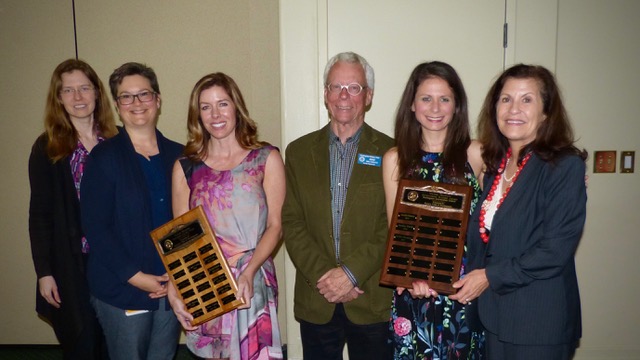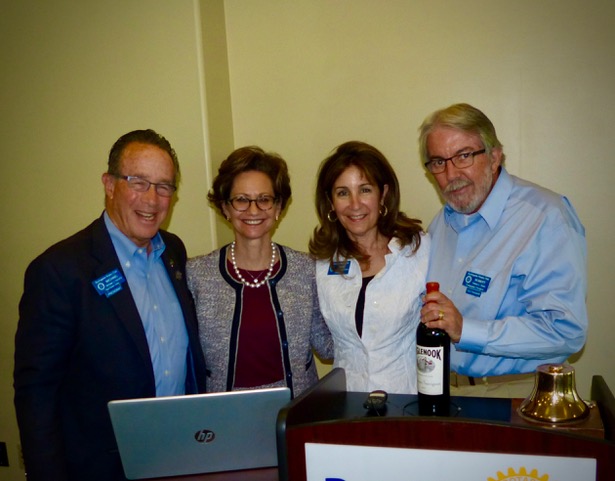Pledge and Invocation

President Mike called the meeting to order and requested that Sean Williams lead us in the Pledge. That was followed by an invocation by the good Dr. Paul Nieberding.
Visiting Rotarians & Guests: Visiting us from the Millbrae Club were Tom and Faye Dawdy. Karen Malekos-Smith introduced her guest, Zelda Levin. Zelda was proudly wearing her Paul Harris medal having been the first women to be awarded this by the San Carlos Rotary Club. Doug Winnett brought his lovely wife Catherine.
Announcements
 Mike Heffernan then introduced our annual Teacher of the Year awards. He gave a bit of history of the late Vic Mangini, Rotarian and former BHS teacher and coach, whose many accomplishments in education inspired the creation of this award. Burlingame High School assistant principal, Valerie Arbizu, introduced Shannon Couch, this year’s winner. Maggie MacIsaac, Superintendent of the Burlingame School District and Rotarian, introduced Christina DeGregorio, our winner from Burlingame Intermediate School. Congratulations to both ladies!
Mike Heffernan then introduced our annual Teacher of the Year awards. He gave a bit of history of the late Vic Mangini, Rotarian and former BHS teacher and coach, whose many accomplishments in education inspired the creation of this award. Burlingame High School assistant principal, Valerie Arbizu, introduced Shannon Couch, this year’s winner. Maggie MacIsaac, Superintendent of the Burlingame School District and Rotarian, introduced Christina DeGregorio, our winner from Burlingame Intermediate School. Congratulations to both ladies!Bob Doerr reminded us all of our upcoming fundraiser, Burlingame Bistro, to be held Sunday, May 20th at the DoubleTree Hotel.
Program
Karen Malekos-Smith introduced our speaker, Dr. Harriet Borofsky. Doctor Borofsky is a radiologist affiliated with Mills-Peninsula Medical Center and director of breast imaging. After some AV problems were finally solved she began her presentation on the Early Detection and Diagnosis of Breast Cancer. Dr. Borofsky informed us that breast cancer is very common and one of the most frequently diagnosed cancers. The good news is that the death rate has been decreasing and it is now highly curable. The risk of developing breast cancer increases with age. The men in the audience were comforted to learn that breast cancer in men is quite rare….but it does happen.
Dr. Borofsky listed a few of the elevated risk factors for breast cancer. One is the gene mutations of the BRCA-2 and BRCA-1. Genetic testing will reveal the presence of these. She then described the types of breast cancer, one being the non-invasive or in-situ type which comprises 25% of cancers. The second type is the invasive/ductal form which accounts for 75% of diagnoses.
 Why screen? The goal is to test well and healthy women in order to catch the disease as early as possible. The 5 year survival rate is now quite high. The benefits of current screening are borne out by many studies. Catching the cancer early leads to less invasive treatments. There are a few disadvantages such as false positives causing callback anxiety, over treatment and costs. Dr. Borofsky outlined some of the new technologies that increase detection and decrease false positive readings. In addition to ultra-sound and MRIs that can be used for further evaluation, the latest is the Digital Breast Tomosynthesis, more commonly referred to as 3D mammography. The technology takes multiple images of the breast to enable the radiologist to examine areas from multiple angles. The future may hold less invasive diagnostic tools such as blood tests to detect cancers through DNA. We’ll have Dr. Borofsky back to enlighten us on new discoveries.
Why screen? The goal is to test well and healthy women in order to catch the disease as early as possible. The 5 year survival rate is now quite high. The benefits of current screening are borne out by many studies. Catching the cancer early leads to less invasive treatments. There are a few disadvantages such as false positives causing callback anxiety, over treatment and costs. Dr. Borofsky outlined some of the new technologies that increase detection and decrease false positive readings. In addition to ultra-sound and MRIs that can be used for further evaluation, the latest is the Digital Breast Tomosynthesis, more commonly referred to as 3D mammography. The technology takes multiple images of the breast to enable the radiologist to examine areas from multiple angles. The future may hold less invasive diagnostic tools such as blood tests to detect cancers through DNA. We’ll have Dr. Borofsky back to enlighten us on new discoveries.